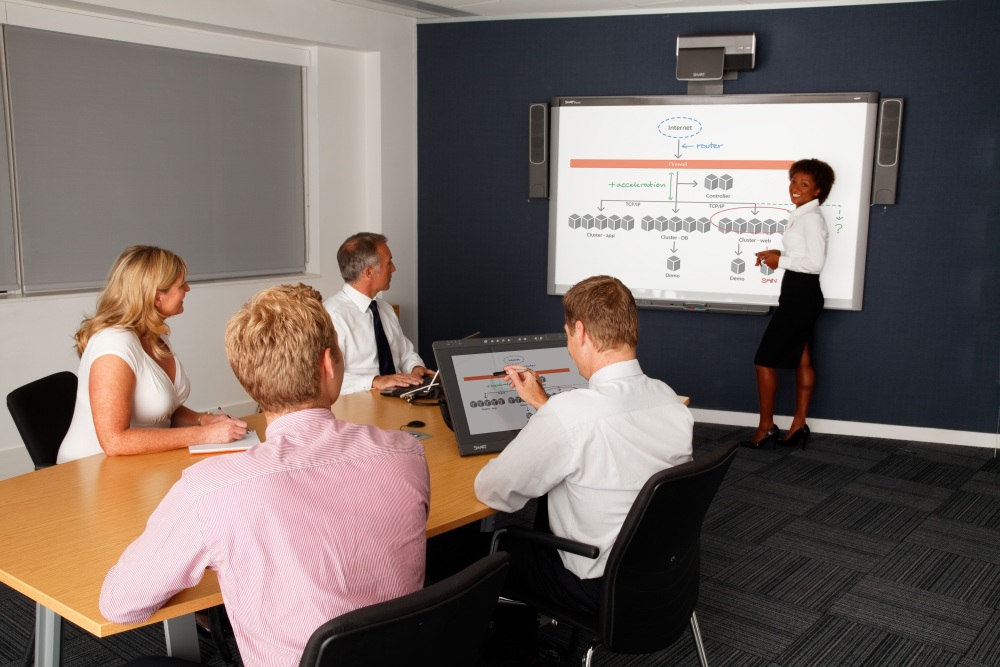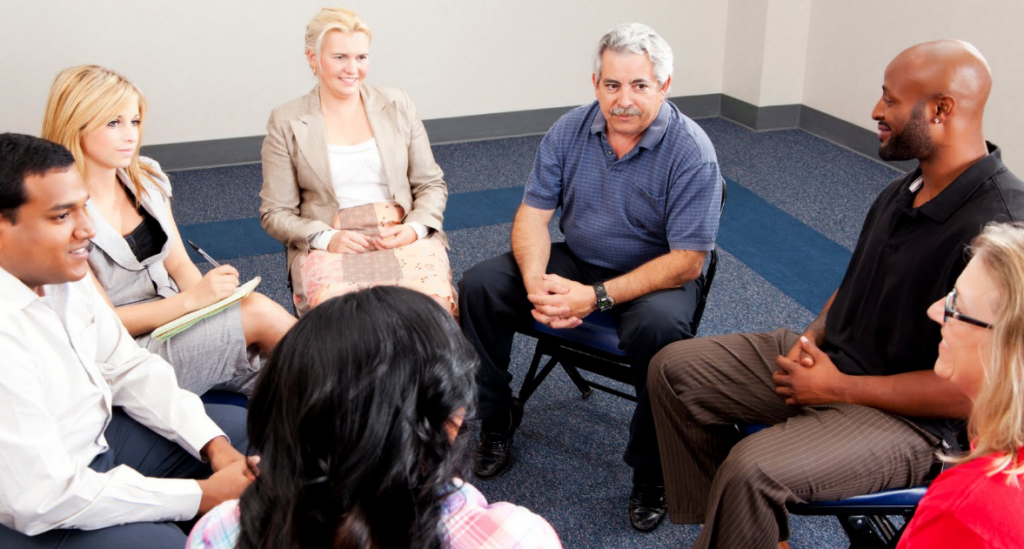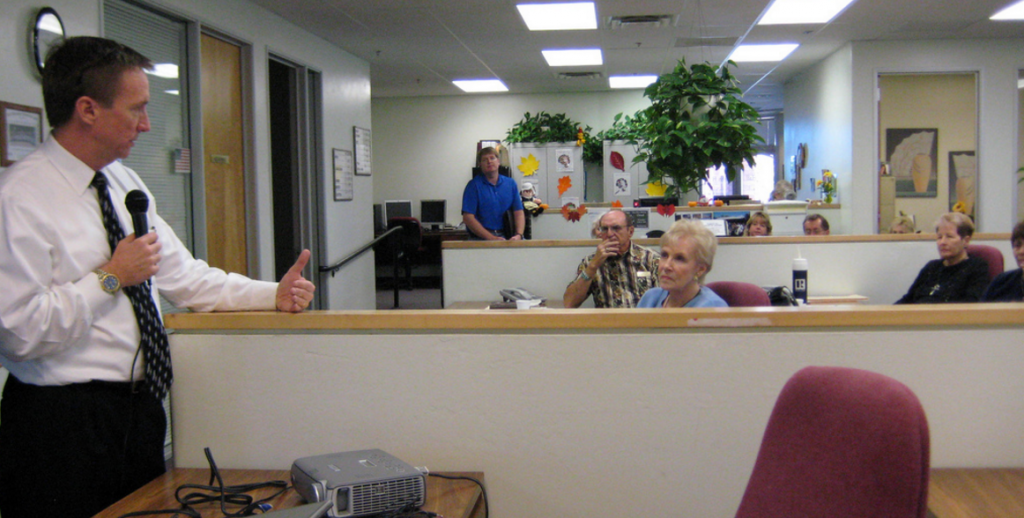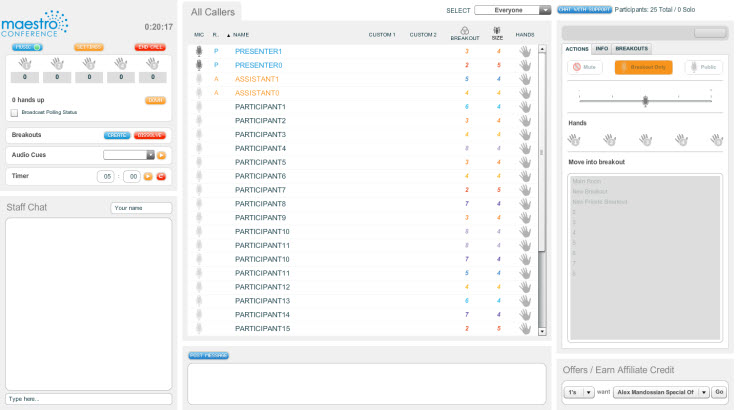How To Make Meetings People Won’t Hate Attending
It’s no secret – most of us love to hate meetings.
In article after article, study after study, research and anecdotal evidence suggests that meetings are easily one of the least popular workplace activities. And for good reason, as most are boring and in many cases amount to a complete waste of time and money.
In fact, a study conducted by Verizon Business revealed that a full 1/3 of meetings are unproductive – completely ineffective. Most meetings suffer from having no clear purpose or objective, they are neither inspiring nor motivating and are too often organized by weak presenters who are unprepared and overly redundant.
Regardless, meetings will remain commonplace in today’s team-based work environment, so you’ll simply have to make the effort to improve them. There are many tried and true ways to do this – sending out invitations early, setting an agenda, encouraging participation, etc. – but even with these measures, most meetings still turn out dreary and dull.
So, let’s take it a step further. Let’s go beyond the run of the mill advice, with some lesser used, more creative tips that will help you spark engagement and foster productive, effective meetings that people won’t mind attending.
What Exactly Is A “Good” Meeting?
First, we need to understand the characteristics that define good meetings. In short, a meeting is a “good” one when it is:
- Effective: Effective meetings result in actions that actually meet the goals set out in the agenda. They get things done.
- Engaging: The meeting commands interest. People actually care about what’s going on, they pay attention and want to follow along.
- Positive: Attendees feel positive about the goals and objectives of the meeting and understand the path to achieve them.
- Open: The best way to collaboratively solve a problem or meet an objective is by being transparent, open and honest with those in attendance.
7 Ways To Keep Your Meetings Short, Engaging And Effective:
1. Get The Ball Rolling With A Smile
Team, listen, we have to deliver this product by next week and we are just halfway to completion. Now, I understand that you have all been working hard at this, but I need more from you. I need much more! For this week, I need 200%, whatever it takes. When you signed up for this job, you were told that it requires sacrifice and that’s what I am looking out for this week. We must, must get on this in a more serious way, otherwise, we will lose the client and a lot of revenue!
That, versus:
Guys, firstly, thank you all for the immense effort that you have all put into this project. I want you all to know that I really appreciate your hard work. It has been heartening to see you all excel and push your limits, congrats! We have fought hard guys, but we still have the greater part of the battle to conquer and I will need you to push beyond your limits even more so this week since we have a hard deadline for next Monday. This is an important goal, guys, let’s give our all to achieve it!
See the difference?
The way a meeting starts sets the tone for the rest of the session. Start with anxious maundering and people will be uneasy, nervous and flustered by the end.
As the host, start the meeting by being:
1. Positive: If your outlook isn’t positive, then what is the point of the meeting? Clear motives, purpose, and focus create a positive outlook. Think about the end goal and align the meeting towards that.
2. Empowering: The goals of the meeting are your responsibility and everyone in the room needs to feel encouraged to try their best to complete the task at hand. Empower team members by speaking of their past successes, letting them know that you believe in their abilities and encourage them to push their limits.
Don’t Start With:
1. Throwing Blame: First, let me point out that personal responsibility is very important. However, it’s never a good idea to begin a meeting by throwing around blame. The aim should always be to move forward and not regress by blaming people. Instead, at the appropriate time in the meeting, let team members understand where they feel down with their responsibility and more importantly, how to resolve it and make better of the situation. Blame tends to get cast around until it’s nobody’s problem.
2. Complaints: Complaining drains people, even if you are not complaining about them. It’s one thing to identify a problem, express the effects of it and seek to rectify it. It’s another thing to simply complain about the consequences of the problem.
3. Focusing On Problems: Starting a meeting positively and lively means refusing the temptation to lament the effects of the problems. In fact, there’s only one type of conversation that you should have regarding the problem early on and that’s how to clearly define the issues. Later in the meeting, you can express the effects of the problem to help attendees understand the seriousness of the situation. In fact, skip talking about the effects of the problem that people already know. In cases wherein team members already understand the consequence of the issue, focusing on it will only seek to frustrate.
How Do You Start A Meeting Positively? Here Are A Few Tips:
- Speak of past accomplishments as a direct result of past, effective meetings.
- Mention positive outcomes that you’re looking forward to from the current meeting.
- Mention something interesting or funny that you’ve learned since the last meeting.
- Share insightful information that attendees might not have known.
By starting positively, you’ll lighten the mood regardless of the intense nature of the meeting. Moreover, it will set a good tone for the rest of the session and open channels for better interaction.
2. Don’t Just Break, Re-Energize
Have you had meetings wherein halfway through, you were wondering why you were there in the first place? It happens. How can you not expect that reaction when a meeting is going on for five hours on end?
Time is everything and you want to make the most of the time allotted for your meeting, I know. However, it’s better to have a 30-minute meeting with 5 engaged minds than an hour long meeting with 10 people counting down the minutes.
The truth is, people have short attention spans and so it’s important to break your meeting into smaller segments to keep them engaged. Attendees need time to digest information, to think a little, to breathe and to go to the restroom!
Breaks That Re-Energize
During breaks, most attendees scour their email, check their phones and some simply stare into space.
Your breaks should allow your attendees’ space and time to process the information and to feel refreshed going into the next session.
There are many smart ways to use meeting breaks:
- Ask everyone to take a walk or get outside for 10 minutes of fresh air.
- Lighten the mood with a joke or story.
- Come up with something clever such as a riddle or trick question.
- Talk about sensational news.
- Lead attendees through breathing exercise.
- Serve sweet treats (dark chocolate, anyone?), coffee or tea.
Just do something other than talk about work.
How Many Breaks Should You Have?
Ideally, you should have a 5-minute break every 30 to 45 minutes depending on the complexity of the minute.
So, if you have a two-hour meeting starting at 2 PM, include these breaks:
- 2 PM: Meeting starts
- 2:30 PM: Five-minute break
- 3 PM: Two minutes break
- 3:30 PM: Two-minute break
- 4 PM: Meeting ends
3. Get Rid Of That Table
Have you ever wondered why support groups, focus groups and similar gatherings that require intense reasoning often sit in a circle, without a table in between?
It’s because that seating arrangement creates an avenue for real, open, rich communication.
In general, tables restrict the flow of communication. A table doesn’t really serve any other purpose in a meeting than providing a place for people to put their notebooks and laptops. Oh, it’s also a great place to rest your head if you happen to fall asleep!
There are several benefits to an open, table-less format:
- No one can hide their phone to one side, as everyone will see!
- You can speak directly to everyone at once.
- People can’t just slump down and hide throughout the meeting.
- On some physiological level, the arrangement signals that everyone’s opinion is equal, unlike the normal meeting table setting, where the boss sits at the head of the table.
4. Silence Is Golden
A very long meeting is about to end and you’re relieved, but there’s this one guy who just won’t stop talking. Even when his words are fluff and of no effect, he simply goes on and on. Even when it’s obvious everyone is tired and flustered, he continues. Even amid the angry states and unusually loud sighs, he’s not daunted.
It’s a frustrating experience. Yet, silence is powerful, and that’s no less true for meetings.
But, isn’t the whole point of meetings to talk? To share ideas and discuss issues?
Many meetings go on for hours, laden with speeches, yet accomplish nothing because people end up confused or annoyed and fail to make a personal contribution. Giving people space for thinking is as important as ensuring they participate verbally. In almost all cases, silence is as important a factor as speaking in meetings, particularly when complex ideas are being discussed.
Silence Encourages Reflection
Speaking does not equate to engagement. Creating synergy and momentum within your meetings means allowing people time to internalize issues and discovering their own ideas and personal feelings.
Silence is important for this process for a few reasons:
- Sometimes more reserved people can’t get a word in edgewise.
- Not everyone does well with rapid conversations and cross-talk.
- For some people, complex conversations are extremely difficult to follow.
- When energy escalates in the room, some people will need a breather.
- Sometimes, team members will need time to find information, refer to notes or simply get their wits about them.
Generating synergy is not just about getting people to talk, it’s about getting the best, most reasoned responses from them. That’s how you generate real momentum, give people time to think and they’ll come up with better ideas. Better ideas will be considered more seriously and participants will become more engaged as they realize their thoughts matter.
When Should You Include Silence?
Here are a few examples:
- When the topic is overly technical or complex by nature.
- When new ideas emerge that require consideration.
- When egos have escalated and tensions are high.
- When you require well thought out responses.
- When people need to search for important information.
Whenever complex ideas are expressed or whenever critical decisions need to be finalized, stop and give participants a chance to mull it over.
Is This Really A Major Issue?
You may not immediately realize why this is a major issue and that’s understandable; because the effect of not allowing people time to think is not immediately obvious. However, chaotic meetings tend to lead to groupthink, wherein participants grab onto the immediately ‘obvious solution’. That is, the solution that everyone else seems to have arrived it; instead of thinking for themselves and discovering how they really feel about the issue.
At the appropriate time, announce a two or three minute period of silence to allow people to digests information and formulate their own ideas. All it takes is two minutes without opinions flying around the room to think about the deeper issues and respond appropriately. You’ll surely create richer conversations that way.
5. Not Just Yet, Mr. CEO
The general flow of most high-level meetings goes something like this:
- The CEO or General Manager speaks.
- Then the Operations Manager or someone else in mid-level management speaks.
- The floor is then open to everyone else (associates, interns, etc.) as dictated by the meeting host.
The point is, people higher in the hierarchy speak before everyone else. At first glance, you might not see an issue with this. After all, that’s how the corporate world operates with everything else, from salaries and benefits to seating arrangements. It’s all a pyramid.
The problem, however, is that whenever higher management speaks first, those lower in the hierarchy automatically feel that they have to concur with their superiors, rather than expressing their own opinions. In fact, I’ve seen cases wherein people right out refuse to disagree with their superiors openly because they believe it’s disrespectful. This even occurs in cases wherein the superior in question is wrong, as a matter of fact, and not opinion.
This kind of influence results in four problems:
- New, and in many cases important ideas don’t come to the fore.
- Any spark of creativity is dampened.
- Politics gets in the way of forwarding movement.
- The people who are on the ground and in the trenches doing the job don’t have a real voice.
Flipping the pyramid gives management a chance to comment on their employees’ real thoughts and opinions. It creates an open and honest environment in which solutions are easier realized.
6. Quit Brainstorming
You’ve surely been in those sessions wherein you’re told there are ‘no bad ideas’. Everyone is asked to let their mind run wild and just conjure up ideas, just brainstorming! The problem is, in most cases, brainstorming sessions are dead ends because brainstorming is largely a hit or miss activity. It bleeds the creative process by favoring first ideas and by lacking direction.
To pounce upon effective ideas, you need to give your participants specific enough goals; by breaking down each aspect of the problem into very specific areas and having each person or group attack each sub-idea with a clearly defined purpose. This will give direction and allow for teamwork.
Here’s a great way to break down and build up ideas:
- Have each person jot down a few ideas on their own piece of paper.
- Have them trade papers with other participants who should then build on those ideas.
- Rotate the papers a few times.
- Start a discussion based on the new ideas that emerge.
New and interesting ideas almost always arise from this process. Team members can then discuss these concepts and formulate a winning plan!
7. Don’t Ignore Technology
Numerous advances in technology are available for creating effective meetings that are easier to facilitate, more engaging and exciting. Yet, even technology companies fail to use these tools to reduce frustration and improve their meetings.
Here are just a few handy tips for incorporating technology into your daily meetings:
- Eliminate Meeting Clashes: You step into a room you booked for 1:00 – 2:00 PM, just to realize that someone else booked it for, you guessed it, 1:00 – 2:00 PM. Don’t simply rely on Outlook to schedule meeting rooms, there are several dedicated tools for workspace scheduling. In fact, many will allow you to setup agendas, create group calendars, integrate with Outlook along with several other impressive features. Your participants shouldn’t be flustered before the meeting even starts.
In fact, you could even use a mobile app to provide scheduling on the go. Same could then be displayed on a fixed tablet in each room.
- Use a Productivity Tool: Organization is critical for seamless meetings. Think about your specific organizational needs and find a productivity tool that can help you improve your processes.
- Mobile Apps: Of course, there are mobile apps that can do much more than scheduling. There are apps for meeting planning, itineraries, creating handbooks, sharing files, social media integration, etc.
- Video and Teleconferencing: Virtual meetings are a recipe for multitasking, especially if attendees experience choppy video or sketchy audio. Offering a quality video/teleconferencing experience means going beyond just a powerful broadband connection. It means finding a service provider with a stable virtual conferencing platform, offering the right grade of technology at an affordable price.
More importantly, if you are considering adopting a video conferencing solution, take the time to do proper research and be guided by a proven process. In fact, ensure you take advantage of a free trial for at least a month. This should give you a good time to realize the benefits of a solid video conferencing system.
- Use Interactive Projectors/Whiteboards: Impress your attendees with a sleek interactive projector and whiteboard. With these devices, computer images can be displayed on a whiteboard using a smart digital projector. The meeting host/instructor can then manipulate the image directly using a stylus or his/her finger as a mouse. Interactive whiteboards will allow you to draw shapes, underline items, create highlights, etc.
In fact, some devices allow attendees to participate as well. This means team members will be able to edit the virtual document together. This type of visual is memorable and will get your message across in a vibrant manner. Now, that’s just awesome.
- Use A Virtual Meeting Solutions Platform: Virtual meetings are a must for larger organizations and distributed teams. These meetings often see 15+ participants in a single go. Improving these sessions means going beyond the regular Skype call to using a fully-fledged online meeting tool.
The major benefit here comes with the rich feature-set offered by these platforms, including shared browsers, virtual room walking, webcam integration, polls and breakout rooms.
Conclusion
Boring meetings will zap your attendees’ energy and cripple their creativity. It’s a recipe for frustration and time wasting. Moreover, it keeps people from getting real work done. Follow the suggestions above and allow people to be open, to share new ideas and make efficient use of company time and resources. Switch the focus from packing as much information as possible into the shortest period of time to creating synergy as well as being energized, creative and engaging.
Have you been in a meeting you loved? If so, what made you love the meeting rather than hate it? Please share in comments below!












